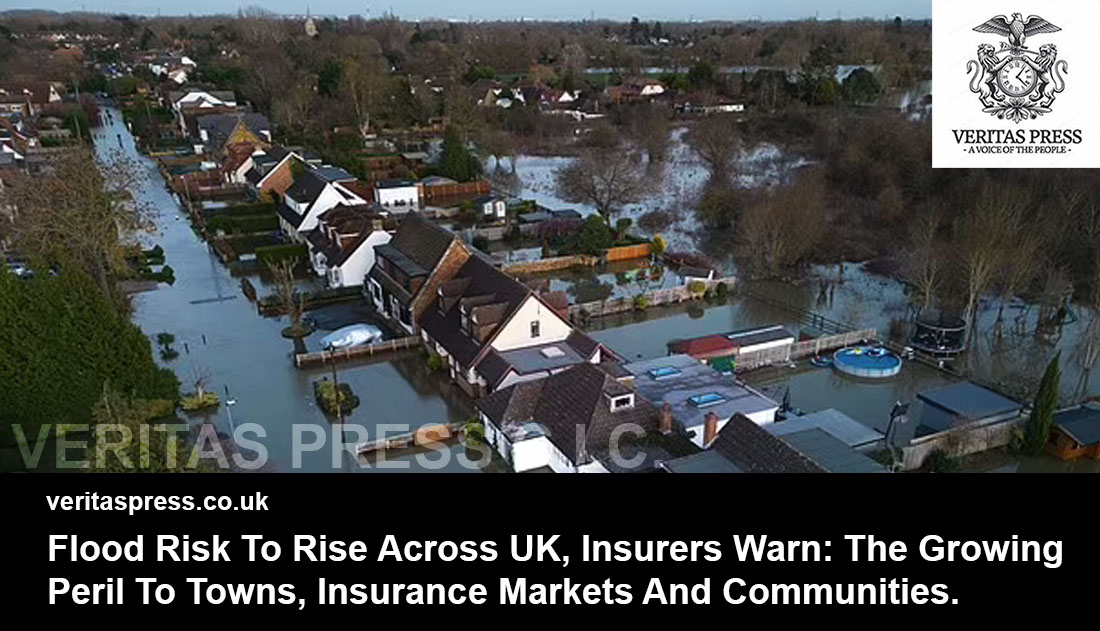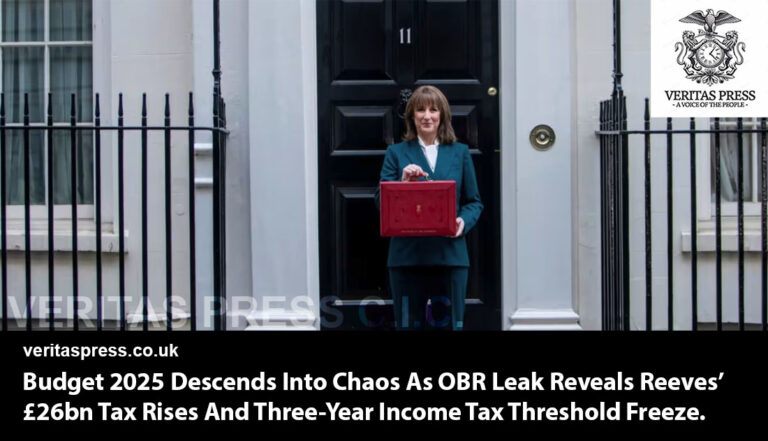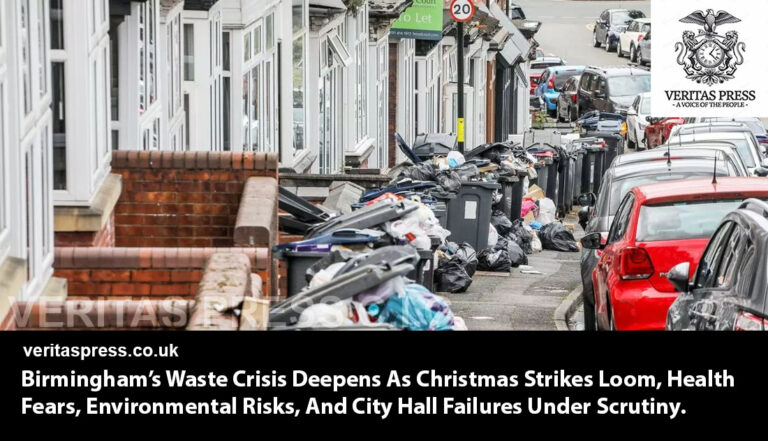
Insurers shout; politicians pledge; communities pay. But the plumbing, the planning and the politics still don’t add up.
When insurers start publicly mapping which towns are likely to be uninsurable, an urgency that once lived in academic reports and activist pamphlets becomes an economic fact. Aviva’s new constituency-level analysis, and the Guardian investigation that published it, show that every parliamentary constituency in Great Britain will face increased flood risk by 2050, and many will see catastrophic rises in properties at risk. In England alone, Aviva projects properties exposed to flooding will rise from 6.3m to 8m by mid-century, with flash (surface-water) flood risk rising even faster. That is not a forecast to be filed under ‘possible,’ it is a business calculation being shouted from the rooftops of finance.
This investigation drills into three failings that flow from those numbers: (1) a market signalling crisis in insurance that will become social policy in drag, (2) planning and housing policy that remains dangerously misaligned with climate realities, and (3) an adaptation strategy dominated by announcements and pilots rather than hard, systemic change.
1) Market Signals: Insurers Are Not “Campaigning,” They’re Pricing A New Geography Of Risk.
Aviva’s Jason Storah is explicit: “We’re not in this because we’re climate campaigners… This is a hard-headed calculation; we’re looking at the numbers.” When a major insurer publishes constituency-by-constituency exposure tables and warns that millions more properties will be at risk, markets react. That reaction already looks like re-assigning value from vulnerable places to safer ones.
Flood Re — the government-industry reinsurance pool created to stabilise household cover, is under acute pressure. Its chief has warned that global investors are “hitting the limit” on absorbing rising reinsurance costs, and reinsurance costs have surged. That matters because Flood Re has been the stopgap that prevented many households from being priced off the market; its scheduled wind-down in 2039 is now a glaring cliff-edge. If Flood Re exits without an alternative, private insurers will increasingly apply market pricing or withdraw capacity entirely, and that will cascade into mortgage markets, banking collateral values and local economies.
Investigative sting: insurers are not just passively reporting; they are reshaping land economics. Aviva’s own publications and guidance now push for mandatory resilience and different underwriting. That voluntary pivot is welcome, but voluntary shifts redistribute risk without democratic accountability. Which places should the market be allowed to mark “uninsurable”? Who decides whether a town gets a defence upgrade or is told to retreat? These are political questions cloaked by actuarial tables.
2) Planning And Delivery: Promises Of Billions, But The Pipelines And Rules Still Leak.
The government’s headline response, a £10.5bn package to protect 900,000 properties and reforms to speed delivery, is real money. But it must be judged against scale and incentives. The country already has 6.3 million properties at risk; Aviva’s scenario would add another 1.7 million in England alone. A multi-billion-dollar capital pot is meaningful only if spending is strategic, rapid and paired with rules that stop adding new exposure through poor planning.
Here, the evidence is sobering:
• New homes are still being built in risk zones. Aviva and other analyses show tens of thousands of new homes have been built in recognised flood zones over the past decade, a pattern that could put a large slice of the government’s proposed 1.5m new homes in the wrong places. That is not an accident: it is a systemic failure of planning incentives.
• Delivery problems are endemic. Parliamentary inquiries and recent audits emphasise fragmentation, delayed schemes and cost overruns. Tenbury Wells, repeatedly flooded and now with public buildings declared uninsurable, is the human face of that failure: a town for which a flood defence was scrapped after costs ballooned. When defences are cancelled, entire local economies are put on life support.
• The institutional gap remains. Multiple bodies (local authorities, drainage boards, national agencies) share responsibility, but no single, accountable national architecture directs adaptation at the catchment or national scale. The Parliamentary Environmental Audit Committee has urged clearer leadership, yet debates about an authoritative national body remain unresolved.
Investigative sting: the government’s spending announcement is necessary but insufficient. Without legally binding planning reform (hard exclusions for new builds in high-risk zones, mandatory resilience standards for all new homes, and a national prioritisation framework tied to equity), billions may rearrange short-term risk rather than remove it.
3) Climate Justice And “Flood Poverty”: Who Pays When The Market Abandons A Town?
Insurance is not an abstract instrument; it’s a distribution mechanism. Dr Mark Andrew (Bayes Business School) and others warn that when market pricing prevails, lower-income households concentrated in flood-exposed neighbourhoods will be worst affected. That’s “flood poverty” in practice: loss of cover, devaluation of assets, and a public-cost backstop that is both regressive and politically fraught.
Activist groups frame the moral problem bluntly. Extinction Rebellion and campaign coalitions argue insurers must both stop underwriting fossil fuel expansion and use their leverage to push for strong adaptation and public protection, otherwise they profit from the very activities worsening the risks they then charge households to insure against. Greenpeace and Friends of the Earth emphasise that corporate and political inaction has socialised the cost of climate harms onto the poorest. Those voices are not romanticism; they are calls for structural accountability: who gains from building in risk zones, and who pays when the levee fails?
Lesley Davies, deputy mayor of Tenbury Wells, captures the local reality: residents and small businesses “feel abandoned” as coverage and investment evaporate. If people lose insurance access for key public buildings and businesses, abandonment becomes economically rational and socially catastrophic.
4) Science And Adaptation: Solutions Exist, But Implementation Lags.
Climate scientists and hydrologists are clear: a mixture of hard engineering and nature-based solutions (floodplain reconnection, wetlands, upstream land management) reduces systemic risk and delivers co-benefits. Dr Jess Neumann (University of Reading) says current spending is a “small step” relative to the scale of properties at risk; the Committee on Climate Change stresses the need for long-term adaptive planning and improved standards. Nature-based strategies must be scaled and joined to retrofit and resilience programmes for the poorest households.
But implementation is where the science meets politics: reconnecting rivers to floodplains often requires land-use change and compensation; upgrading urban drainage requires cross-departmental delivery; and managed retreat is a politically toxic, but increasingly necessary, tool in some catchments. The technical answers are not the obstacle; the political appetite and funding models are.
5) A Sharper Policy Scorecard: What Decision-Makers Must Do Now.
Immediate: legislate planning exclusions. Make it illegal for new large-scale residential developments to be approved in mapped high-risk river/coastal flood zones unless they meet demonstrable, independently-verified resilience criteria. (Evidence: Aviva mapping showing new homes in risk zones.)
- Replace Flood Re with a fairer national mechanism before 2039. The successor must protect low-income households, subsidise “build back better” standards after floods, and incorporate a transparent process for triaging which places receive long-term defence investment. The market cannot be the only arbiter of livability. (Evidence: Flood Re strain and investor limits.)
- Create a single national flood-resilience authority. Give it budgetary control, planning veto powers and clear catchment-level responsibilities. Parliamentary scrutiny shows current fragmentation impedes scale.
- Tie infrastructure funding to social equity. Reserve a ring-fenced share of national flood funding for deprived communities and for retrofitting lower-income housing (not just headline defence projects). Otherwise, the policy will widen inequality.
- Mandate insurance-linked resilience standards. Require insurers and mortgage lenders to support retrofits where feasible, and make “build back better” provisions enforceable after claims. Aviva’s loss-prevention standards already provide a blueprint.
6) Final Investigative Judgement, Three Uncomfortable Truths:
- This is not a local problem anymore. When nearly every constituency faces higher flood exposure, adaptation must be national and redistributive, not ad-hoc charity or post-disaster grants.
- Markets are signalling retreat in plain sight. Insurers are not ideological; they are recalibrating economic geography. Without a public plan to absorb the social costs, retreat will be arbitrated by wealth and postcode.
- Political choices still trump technical possibilities. The tools to reduce risk at scale exist: engineering, natural flood management, planning rules, and insurance reform, but present policies still prioritise growth in risky places and incremental funding over structural reform. The question is political will, not technological scarcity.
Voices (selected):
- Jason Storah (Aviva): “We’re not in this because we’re climate campaigners… This is a hard-headed calculation; we’re looking at the numbers.”
- Perry Thomas (Flood Re): warns that global investors are “hitting the limit” for absorbing UK flood risk and that the scheme faces surging reinsurance costs.
- Emma Boyd (former Environment Agency chair): warns some areas “may become too expensive” to defend.
- Dr Jess Neumann (Univ. of Reading): current funding is a “small step” relative to the scale of properties at risk; we need more investment and smarter planning.
- Tenbury Wells deputy mayor Lesley Davies: “We do feel abandoned” as insurers and investors pull back and defence plans fail.
- Extinction Rebellion / Greenpeace (campaigners): frame the issue as climate justice, insurers and builders must be held to account for who profits and who pays.
How I Investigated This: Sources And Constraints.
This critique cross-checked Aviva’s published analysis and press materials, the Guardian’s investigative reporting (which published Aviva’s constituency analysis), FT reporting on Flood Re, government announcements on the £10.5bn package, and expert commentary from academics and adaptation bodies. Where reporting quoted local figures (e.g., Tenbury Wells), I used those local interviews to show the human consequences of policy and market failure. Key sources: Aviva (Building Future Communities materials), Guardian investigation, Financial Times (Flood Re), government press release, University of Reading expert comment, Parliamentary Environmental Audit Committee report, National Flood Forum.
Conclusion: An Editorial Call To Action.
Numbers alone should not be the final arbiter of habitability. But now that insurers, scientists and campaigners are aligned on the facts, more properties, more flash floods, and a finite private market capacity, the UK faces a stark choice. Will adaptation be a public project: planned, financed and fair? Or will it be an emergent market outcome: postcode by postcode, with the poorest left first in the wet? The evidence warns that without a legally backed, nationally coordinated plan that links planning, insurance reform and equitable funding, the management of flood risk will become a slow, regionalised abandonment, a political failure dressed as market realism.






























